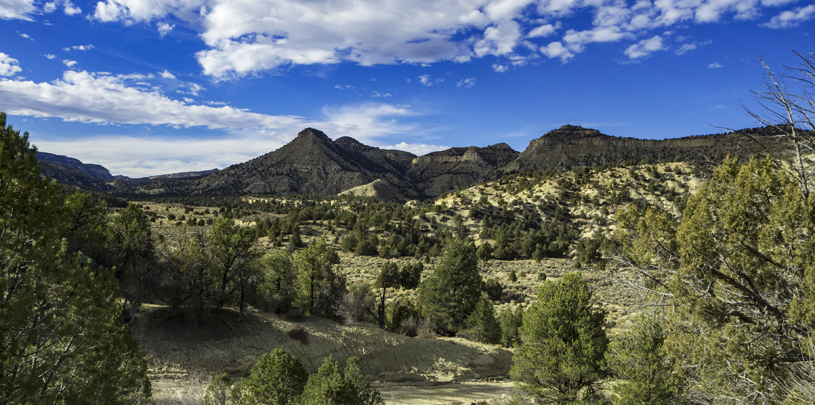
 by Kamran Zafar, Field Attorney
by Kamran Zafar, Field Attorney
Utah’s Grand Staircase-Escalante National Monument is famous for its dinosaur fossils, its starry skies, and the 660 species of native bees that serve as postal carriers of pollen for the monument’s desert plants. Meanwhile, the monument’s impressive pinyon and juniper forests — home to cultural and archaeological sites and important habitat for disappearing species like the pinyon jay — have gotten less attention. But if the Trump administration’s plans to eliminate pinyon and juniper go ahead, thousands of trees could vanish from the monument forever. And these plans would move forward regardless of who wins the legal battle to restore the monument’s original boundaries.
 A "bullhog" grinds pinyon and juniper trees into mulch at the West Coal Creek area northeast of Price, Utah. UTAH DIVISION OF WILDLIFE RESOURCES
A "bullhog" grinds pinyon and juniper trees into mulch at the West Coal Creek area northeast of Price, Utah. UTAH DIVISION OF WILDLIFE RESOURCES
The Bureau of Land Management (BLM), the federal agency in charge of the monument, is proposing projects to change what is growing where in and around the national monument, including eliminating pinyon and juniper trees using destructive methods. One technique involves using giant shredders that can reduce whole stands of trees to fields of wood chips, uprooting and smothering everything in their path.
The size of some of these projects is sobering if you consider the delicate ecological balance necessary for plants and animals to thrive in this arid landscape. Inside and around Grand Staircase-Escalante National Monument, these include:
In March 2019, after several years of participating in the public comment process, the Grand Canyon Trust and partners filed an appeal challenging the BLM’s decision to go ahead with the Skutumpah Project, which would potentially be the kiss of death for thousands of trees on over 30,000 acres of lands within the original monument boundaries.
The BLM claims it needs to improve existing sage grouse habitat — sage grouse, as the name suggests, need sagebrush to survive — by cutting down pinyon and juniper trees so that sagebrush can grow. The BLM also says it wants to reduce the risk of wildfire. The Grand Canyon Trust fully supports sensible efforts to reduce wildfire risk and preserve sage grouse habitat. But the science doesn’t support the idea that getting rid of pinyon and juniper trees will do either of these things. And taking out pinyon and juniper will harm the monument, including churning up soils and destroying the monument’s precious biological soil crusts. These crusts retain moisture, prevent erosion, and help keep desert soils healthy, supporting hundreds of desert species at the bottom of the food chain.
The Skutumpah Project would also harm species that depend on pinyon and juniper trees, including the pinyon jay, whose population nationally has already declined by an estimated 85 percent.
 Male greater sage grouse in central Utah. TOM BECKER, UTAH DIVISION OF WILDLIFE RESOURCES
Male greater sage grouse in central Utah. TOM BECKER, UTAH DIVISION OF WILDLIFE RESOURCES
When it comes to sage grouse, the first step should be preserving existing, healthy habitat. Yet 10 miles from the Skutumpah Project boundary, the BLM has given Alton Coal the green light to destroy 1,000 acres of occupied sage grouse habitat.
Some studies show that removing pinyon and juniper does not actually benefit sage grouse and in fact tends to have a negative effect. The elephant in the room here, of course, is grazing. Over 96 percent of the national monument is grazed by cattle and historically it has been grazing, not pinyon and juniper trees crowding in, that has led to the destruction of sage grouse habitat. If the BLM really wants to help sage grouse in the monument, it should focus on the real culprit: livestock.
There isn’t much research to support the idea that getting rid of pinyon and juniper trees reduces wildfire risk. In fact, when you churn up soils by toppling over pinyon and juniper trees, cheatgrass and other invasive species often move in, which can actually increase fire risk.
If the BLM truly wants to reduce wildfire risk, it should concentrate on helping the land adapt to climate change, since drought and warmer temperatures contribute more to wildfires than fuels like pinyon and juniper. If the worry is that these forests are too dense, young juniper trees could be removed by hand-thinning with chainsaws and other minimally invasive methods.
There is growing scientific evidence that removing pinyon and juniper trees may expose the open areas left behind to more sunlight and heat, reducing moisture, and making it easier for wildfires to spread.
The BLM has to follow the National Environmental Policy Act (NEPA) when approving projects like this, which requires the agency to take a “hard look” at the impacts of its actions. In appealing the BLM’s decision to green light the Skutumpah Project, we’re working to send the BLM back to the drawing board to take a hard look at the environmental consequences of destroying thousands of pinyon and juniper trees in the monument's forests. The BLM needs to come up with a better plan, including considering the cumulative effects of the Skutumpah Project combined with the proposed pinyon and juniper removal projects on more than 100,000 acres of land nearby.
A small victory in the legal case challenging Daneros uranium mine, near Bears Ears National Monument.
Read MoreBears Ears petroglyph panels and cultural sites protected by new proposed management plan.
Read MoreFind out how the Bureau of Land Management is planning to protect old-growth forests, creeks, canyons, fossils, and more in Grand Staircase-Escalante National Monument.
Read More